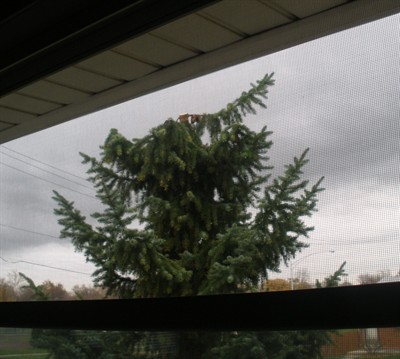Restoring conifer to tip-top shape
The things that stand out in winter...!
1) A tree trimming crew is coming to prune the fir in my
back yard, which lost its top to borers. I'm giving the
crew pictures from your Trees magazine, about
how to
establish a new leader, to give the tree a new pointy tip
rather than a flat top. We did that at your workshop but I have to
give the crew the picture because I can't go up on the ladder to
show them how, or I don't think they will let me
anyway.
2) Well, the top is off my spruce, and wow, can you see
the holes made by the borer! It ended up with one side shoot that
might become the new leader. The tree company wanted to trim it off
with the pole pruner but I said NO.
Will that branch take over eventually? It looks funny at
this time, but so what. - M.M. -
Great photos, M.M. -- they really tell the tale. (All
photographs on this page ©2012 M.M. c/o this website)
We think that tip will turn up and turn into a good new leader.
It could have been started on its way with some temporary support
to train it upright but we think you'll see it turn vertical so
quickly in spring it'll make your eyes pop.
Firs and spruces are pretty good at recovering from borer
damage. Check out a demonstration of their recovery
power, in the 45 mph department.


The highest point on a tree begins growing first in spring and
is able to regulate growth in cells below so that none match its
speed or overall extension. This is called apical dominance and
it's at work in any plant but particularly strong in fir and
spruce. It's the force that keeps those pyramidal evergreens in
shape. It will be in effect on this tree in spring.
A gardener can encourage and direct this natural re-shaping by
giving an advantage to a particular branch.
Consider M.M.'s fir top at left as in the diagram on the page Train a new
leader. You could strap a cane to the trunk to extend it
vertically. Tie the chosen limb to that cane to keep the growing
tip in a higher plane than any others. Tie loosely and use cotton
cord as you strap the cane and train the branch, so that year's
growth won't be girdled and ties will rot away before causing
trouble.
In addition, shorten competing or potentially competing leaders.
If a tip of a side branch is in or very near the plane of the
selected tip, it can become a co-dominant leader. Multiple tops
will develop. Those tops will have a higher risk of splitting away
from each other as weight builds above their points of attachment
to the trunk. They are also likely to deform the tree's shape.
All the side branches on this fir look to be well below the new
tip's level. Good! But keep an eye on them and have a pole pruner
ready to reach up and nip off any that turn up to give your chosen
tip a run for its money.
